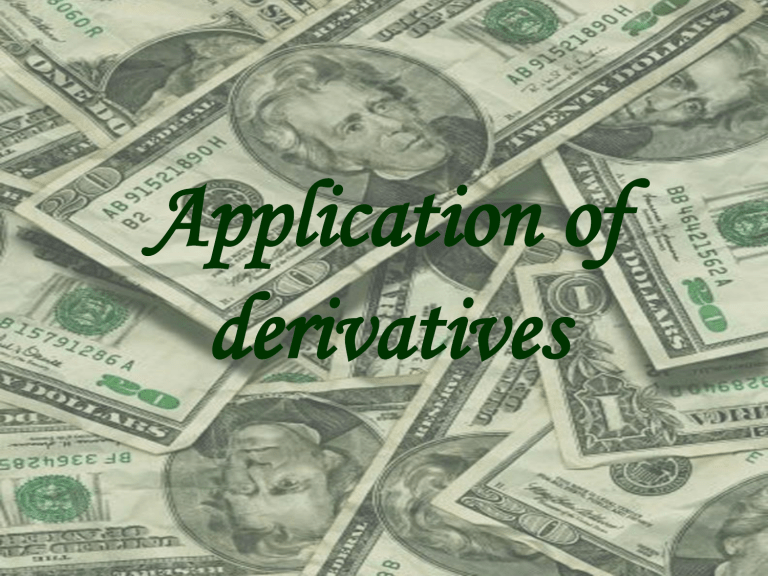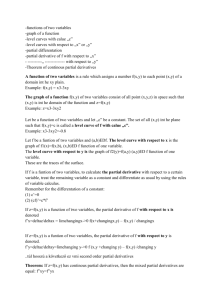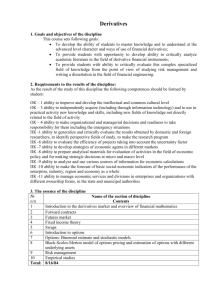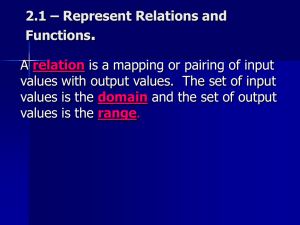P(X)

Application of derivatives
Presented by;
Jihad Khaled Becetti
Kariman Mahmoud
Malak Abbara
Fatma Hussein
Amna Al-Sayed
Wadha Al mohannadi
The content
The definition of derivatives.
The history of derivatives.
The demand function.
The cost function.
The revenue function.
The profit function.
The derivatives
• In calculus, the derivative is a measurement of how a function changes when the values of its inputs change.
• In finance, the derivative is a financial instrument that is derived from an underlying asset's value.
The history of derivatives
• The ancient period introduced some of the ideas of integral calculus.
• In the medieval period, the Indian mathematician Aryabhata used the notion of infinitesimals and expressed an astronomical problem in the form of a basic differential equation. This equation eventually led Bhāskara II in the 12th century to develop an early derivative.
The demand function
Definition;
• A demand function is a fundamental relationship between a dependent variable (i.e., quantity demanded) and various independent variables
(i.e., factors which are supposed to influence quantity demanded) www.classwork.busadm.mu.edu
The MOLL Cinema
The Moll cinema obtains 750 viewers at 30QR in the regular days, and obtains 500 Viewers at price 38QR in special occasions.
Find
1- The demand function
REMEMBER
• Law of demand:
( The quantity of a good demanded in a given time period increases as it’s prices falls, and visa versa)
We could conclude that ;
A- The two points (750,30) (500,38)
B- By finding the slope;
M= 38-30\500-750= -0.032
C- The equation of the line;
P(X)-30= -0.032(x-750)
P(X)=-0.032 .(X-750)+30
So, The demand function is
P (x)= -0.032x+24+30
P (x)= -0.032x+54
The Cost Function
The cost function is a function of input prices and output quantity. Its value is the cost of making that output given those input prices.
C(x)= p(x)
• x
Example
The cost of producing 100 units of good in is
500,000 QR, what is the total cost to produce this amount of output?
Solution
C(x)= p(x) • x
= ( x • p ) • x
= ( 100 • 500,000 ) • 100
= 50000000 QR
The Revenue Function
• Revenue in economics means:
• Amount received or to be received from customers for sales of products or services.
R(x)=x.p(x)
• If R(x) is the revenue received from the sale of x units as some commodity then the derivative R is called the managerial revenue.
• Economists use this to measure the rate of increase in revenue per unit increase in sale.
Casio company
• The demand equation of CASIO Company is:
• P(x) = 5- 1/3 x
Find the revenue:
R(x)=x.p(x)
= x (5 – 1/3 x)
R(x) = 5x – 1/3x 2
The Profit Function
Is the difference between the revenue function R(x) and the total cost function
C(x)
• P(x) = R(x) – C(x)
= x p(x) – C(x)
Chocolate company
• If we Know that the production cost of a chocolate company is = 2x 2 + 8000 +
1200000 ,and the price = -2x + 16000.
Find The maximum profit, and number of units that should be produced for the factory to obtain maximum profit. Then
The price of each unit.
The solution
• P(x)=R(x)-C(x)
• = xp(x) – C(x)
• = x(-2x + 16000) – (2x 2 + 8000 + 1200000)
• = -4x 2 + 16000x – 1208000
Maximizing Profit
If x
0 is a number at which P′(x) = 0 , while
P′′ (x) is negative, then x
0 is a point of local maximum.
To check whether this is a point of absolute maximum, we have to consider the other values of the function over its given domain.
Maximizing Profit
• If P ' (x) =0 ,and P' (x) < 0
We will get the maximum profit.
• P(x) = = -4x 2 + 16000x – 1208000
• → P '(x) = -8x + 16000
• P ' (x)= -8 (x-2000)
• P ' (x)= 0 if x = 2000
• Letting P′(x) = 0 , we get: x = 2000
• Thus x = 2000 is a critical point
We also have:
P′′ (x) = - 8
→ P′′ (2000) = - 8 < 0
Thus x=2000 is a point of local maximum
The profit
P(x) = -4x 2 + 16000x – 1208000
At x=2000, we have:
The profit:
P(2000) = - (2000) 2 + 16000 (2000) –
1208000
= 26792000
The Price
• p(x) = -2x + 16000
At x=2000, we have:
The price: p(2000) = - 2(2000) + 16000
= - 4000 + 16000
= 12000
Graphing P(x)
P(x) = -4x 2 + 16000x – 1208000
P(x) intersects the x-axis at
X = 76.98
and x = 3923.018






